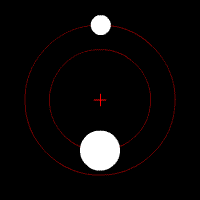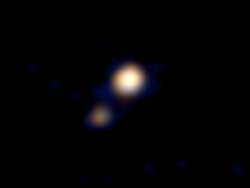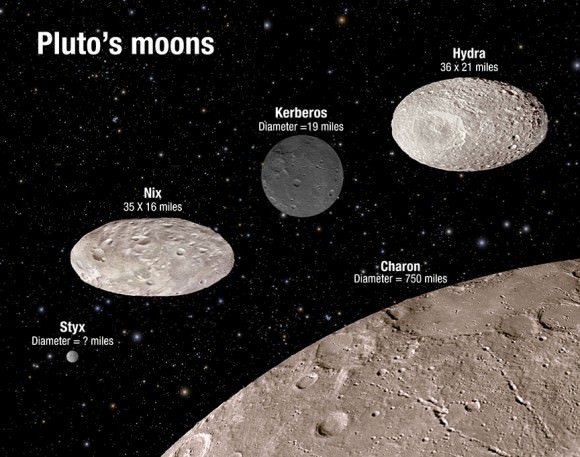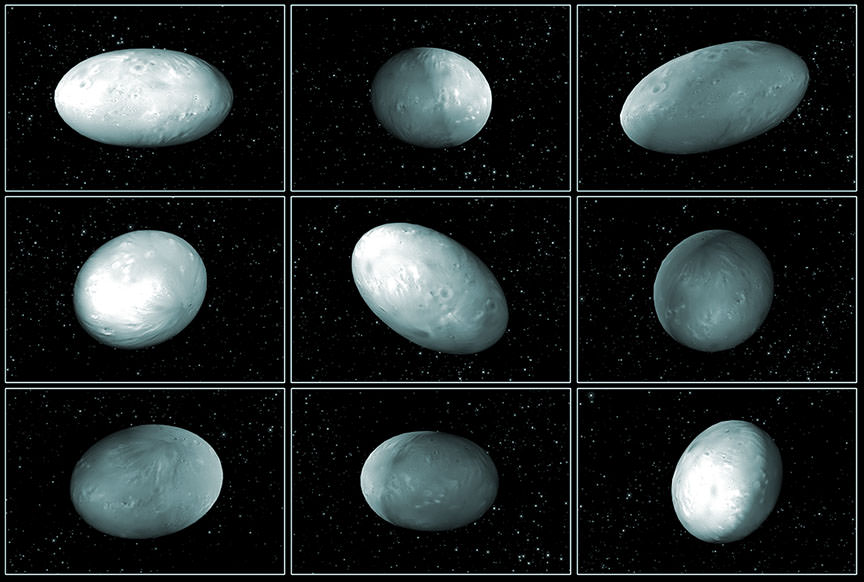Simulation of Pluto’s moon Nix sped up so that one orbit takes 2 seconds instead of 25 days.
Wobbling and tumbling end-over-end like a badly thrown football, Pluto’s moons are in a state of orbital chaos, say scientists. Analysis of data from NASA’s Hubble Space Telescope shows that two of Pluto’s moons, Nix and Hydra, wobble unpredictably. If you lived on either, you’d never know when and in what direction the Sun would rise. One day it would pop up over your north horizon, the next over the western. Every sunset would be like a proverbial snowflake — not a single one the same.
Watch the video, and you’ll see what I mean. Not only does the moon totter, but the poles flip. If there was ever a solar system body to meet the criteria of end-of-the-world, doomsday crowd, Nix is it. The moons wobble because they’re embedded in the bizarro gravity field of the Pluto-Charon duo. Charon is officially the dwarf planet’s largest moon, but the two bodies act more like a double planet because Charon’s so huge.
OK, it’s only 750 miles (1,212 km) in diameter, but that’s half as big as Pluto. Imagine if our moon was twice as big as it is now, and you get the picture.

As the duo dances an orbital duet about their common center of gravity, their variable gravitational field sends the smaller moons tumbling erratically. The effect is enhanced even more by their irregular and elongated shapes. It’s likely Pluto’s other two moons, Kerberos and Styx, are in a similar situation.
Because their moment to moment motions are essentially unpredictable, scientists describe their behavior is chaotic. Saturn’s moon, Hyperion, also tumbles chaotically.

The discovery was made by Mark Showalter of the SETI Institute and Doug Hamilton of the University of Maryland using the Hubble Space Telescope and published in today’s issue of the journal Nature. Showalter also found three of Pluto’s moons are presently locked together in resonance, meaning there’s a precise ratio for their orbital periods.
“If you were sitting on Nix, you would see that Styx orbits Pluto twice for every three orbits made by Hydra,” said Hamilton.
That’s not all. If you’ve ever grilled with charcoal, you’d have a good idea what Kerberos looks like. Dark as one those briquettes. The other moons are as bright as sand because they’re mostly made of ice. Astronomers had thought that material blasted off the moons by meteorite impacts should make them all the same basic tone, so what’s up with Kerberos? No one knows.

Credits: NASA/ESA/A. Feild (STScI)
Pluto’s moons are thought to have formed during a collision long ago between the dwarf planet and a similar-sized object. The smash-up created lots of smaller bodies that eventually took up orbits about the present-day Pluto. Outside of Charon, the biggest leftover, the other moons measure in the tens of miles across. The four little ones — Nix, Styx, Kerberos and Hydra — were discovered with the Hubble scope during surveys to better map the Pluto system before New Horizons arrives next month. No one would be surprised if even more itty-bitty moons are found as we draw ever closer to the dwarf planet.


The elongated shapes suggest tidal stretching – yet the chaotic movement implies no consistent gravitation direction at least now. So…. they were stretched at an earlier time when soft and then moved out and solidified/stiffened and now spin around??
Steven,
The shape you see in the video is idealized. I’m sure the actual shape is more rugged and irregular. Since the moons are likely fragments from a collision they may have been even more irregular in the past. Space weathering and pounding by meteorites may have softened their contours some. It’s possible some fragments were once molten, but doubtless many are just ejected bits and pieces that never melted in the first place. Some of angular momentum in the initial two bodies that collided would have transferred over to the fragments, causing them to spin.
Also, the elongated shape is not necessarily indicative of tidal stretching. There is a minimum mass for an object to maintain a spherical shape (hydrostatic equilibrium). Nix is below that limit. This is from Wikipedia:
“It had been thought that icy objects with a diameter larger than roughly 400 km are usually in hydrostatic equilibrium, whereas those smaller than that are not. Icy objects can achieve hydrostatic equilibrium at a smaller size than rocky objects. The smallest object that appears to have an equilibrium shape is the icy moon Mimas at 397 km, whereas the largest object known to have an obviously non-equilibrium shape is the rocky asteroid Pallas at 532 km (582 × 556 × 500 ± 18 km). However, Mimas is not actually in hydrostatic equilibrium for its current rotation. The smallest body confirmed to be in hydrostatic equilibrium is the icy moon Rhea, at 1,528 km, whereas the largest body known to not be in hydrostatic equilibrium is the icy moon Iapetus, at 1,470 km.”
Bi-polar moon(s) ?
And the surprises are just starting.
On the lighter side, I can just see next year’s talk shows guests promoting their new books…
My horoscope never saw this coming Bob 😀
BC,
Your horoscope is safe ever since 2006 when the IAU demoted it to dwarf planet, lessening its influence on your fate.
In Ian Stewart’s famous 1989 popular introduction to chaos theory, “Does God Play Dice?”, the tumbling orbit of Hyperion is the very first example he uses to show readers what chaos theory is about. Later in the book he returns to that example and examines it in more depth.
Thanks Bob another Fantastic story, With all that close gravity pulling at each other there could be enough heat generated to form liquid on the surface of Pluto or Charon, Also the (many moons) are only there because of the proximity of the 2 dwarf planets keeping the moons in a steady orbit instead of crashing into (a single dwarf planet) We are pretty sure that even our own moon had small moons which crashed into it in its early beginings, We have some exciting times coming soon and I for one cant wait until New Horizons gets there close up….
Hi UFOs,
Thank you. Actually, the tidal tension of Pluto on Charon and vice versa is probably finished as both are locked in an embrace where each only sees the same hemisphere of the other. If you went around the back side of Pluto to its non-Charon facing hemisphere, you’d never see the moon!
I’ll go out on a sturdy limb and say we’ll probably find that Styx and Hydra are very similar to the asteroid Itokawa as visited by the Hayabusa probe. That is to say.. a jumble of gravitationally bound rock, dust, ice and rubble? Itokawa’s rotation was similarly chaotic…
Regardless.. we’ll know soon enough!
There is an interesting article in today’s Science Daily webpage which seems to back up the above statement? Dual lobes anyone?
http://www.sciencedaily.com/releases/2015/05/150528153528.htm